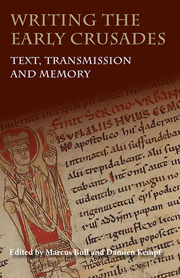Book contents
- Frontmatter
- Contents
- Acknowledgements
- List of Contributors
- List of Abbreviations
- Introduction
- Baldric of Bourgueil and the Familia Christi
- Guibert of Nogent, Albert of Aachen and Fulcher of Chartres: Three Crusade Chronicles Intersect
- Understanding the Greek Sources for the First Crusade
- The Monte Cassino Tradition of the First Crusade: From the Chronica Monasterii Casinensis to the Hystoria de via et recuperatione Antiochiae atque Ierusolymarum
- Nova Peregrinatio: The First Crusade as a Pilgrimage in Contemporary Latin Narratives
- What Really Happened to Eurvin de Créel's Donkey? Anecdotes in Sources for the First Crusade
- Porta Clausa: Trial and Triumph at the Gates of Jerusalem
- The Historia Iherosolimitana of Robert the Monk and the Coronation of Louis VI
- Towards a Textual Archaeology of the First Crusade
- Robert the Monk and his Source(s)
- Rewriting the History Books: The First Crusade and the Past
- The Ideal of Knighthood in English and French Writing, 1100–1230: Crusade, Piety, Chivalry and Patriotism
- Index
Towards a Textual Archaeology of the First Crusade
Published online by Cambridge University Press: 05 May 2014
- Frontmatter
- Contents
- Acknowledgements
- List of Contributors
- List of Abbreviations
- Introduction
- Baldric of Bourgueil and the Familia Christi
- Guibert of Nogent, Albert of Aachen and Fulcher of Chartres: Three Crusade Chronicles Intersect
- Understanding the Greek Sources for the First Crusade
- The Monte Cassino Tradition of the First Crusade: From the Chronica Monasterii Casinensis to the Hystoria de via et recuperatione Antiochiae atque Ierusolymarum
- Nova Peregrinatio: The First Crusade as a Pilgrimage in Contemporary Latin Narratives
- What Really Happened to Eurvin de Créel's Donkey? Anecdotes in Sources for the First Crusade
- Porta Clausa: Trial and Triumph at the Gates of Jerusalem
- The Historia Iherosolimitana of Robert the Monk and the Coronation of Louis VI
- Towards a Textual Archaeology of the First Crusade
- Robert the Monk and his Source(s)
- Rewriting the History Books: The First Crusade and the Past
- The Ideal of Knighthood in English and French Writing, 1100–1230: Crusade, Piety, Chivalry and Patriotism
- Index
Summary
The unusually rich repertoire of historical narratives prompted by the First Crusade remains, in many ways, uncharted territory. Primarily used by historians as mere ‘sources’, as repositories of facts, since the foundations of crusading history as a genre in the nineteenth century, these texts have shaped the constitution of a particular type of historiography that unceasingly seeks to tell and retell a story that was told in different forms by its contemporaries. One can still clearly hear nowadays strong echoes of Heinrich von Sybel's programmatic agenda (back in the early 1840s) to ‘penetrate into the facts and reach the kernel from inside’.
Many questions thus remain to be answered with regard to the historiographical florescence that characterized the aftermath of the conquest of Jerusalem in July 1099. Recent research has shed more light on the contexts in which specific texts were composed, the social and cultural conditions governing their production, but few studies have yet tackled the question of their impact. Who exactly read these texts? What happened to them? What were their repercussions on the society, the culture, and the people of the period? How were they interpreted, and appropriated, by later readers? In other words, what is the story, or what are the stories, behind the story?
In order to address these issues, one needs to move away from a static conception of texts as data, and consider them instead in their dynamic function as literary works, shaped by their intersection with specific actors at different times.
- Type
- Chapter
- Information
- Writing the Early CrusadesText, Transmission and Memory, pp. 116 - 126Publisher: Boydell & BrewerPrint publication year: 2014



